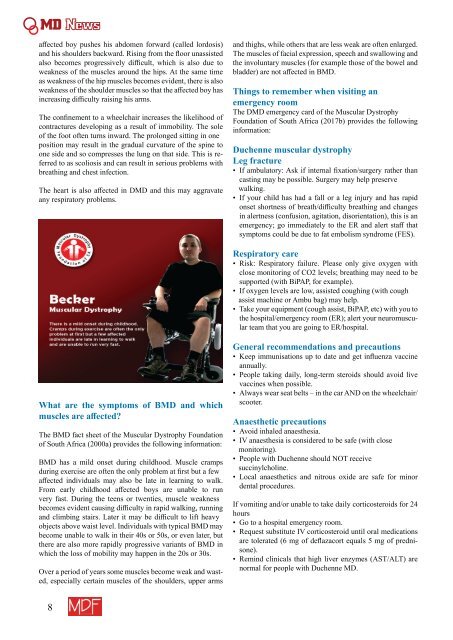MDF Magazine Newsletter Issue 57 December 2018
Create successful ePaper yourself
Turn your PDF publications into a flip-book with our unique Google optimized e-Paper software.
MD<br />
affected boy pushes his abdomen forward (called lordosis)<br />
and his shoulders backward. Rising from the floor unassisted<br />
also becomes progressively difficult, which is also due to<br />
weakness of the muscles around the hips. At the same time<br />
as weakness of the hip muscles becomes evident, there is also<br />
weakness of the shoulder muscles so that the affected boy has<br />
increasing difficulty raising his arms.<br />
The confinement to a wheelchair increases the likelihood of<br />
contractures developing as a result of immobility. The sole<br />
of the foot often turns inward. The prolonged sitting in one<br />
position may result in the gradual curvature of the spine to<br />
one side and so compresses the lung on that side. This is referred<br />
to as scoliosis and can result in serious problems with<br />
breathing and chest infection.<br />
The heart is also affected in DMD and this may aggravate<br />
any respiratory problems.<br />
and thighs, while others that are less weak are often enlarged.<br />
The muscles of facial expression, speech and swallowing and<br />
the involuntary muscles (for example those of the bowel and<br />
bladder) are not affected in BMD.<br />
Things to remember when visiting an<br />
emergency room<br />
The DMD emergency card of the Muscular Dystrophy<br />
Foundation of South Africa (2017b) provides the following<br />
information:<br />
Duchenne muscular dystrophy<br />
Leg fracture<br />
• If ambulatory: Ask if internal fixation/surgery rather than<br />
casting may be possible. Surgery may help preserve<br />
walking.<br />
• If your child has had a fall or a leg injury and has rapid<br />
onset shortness of breath/difficulty breathing and changes<br />
in alertness (confusion, agitation, disorientation), this is an<br />
emergency; go immediately to the ER and alert staff that<br />
symptoms could be due to fat embolism syndrome (FES).<br />
Respiratory care<br />
• Risk: Respiratory failure. Please only give oxygen with<br />
close monitoring of CO2 levels; breathing may need to be<br />
supported (with BiPAP, for example).<br />
• If oxygen levels are low, assisted coughing (with cough<br />
assist machine or Ambu bag) may help.<br />
• Take your equipment (cough assist, BiPAP, etc) with you to<br />
the hospital/emergency room (ER); alert your neuromuscular<br />
team that you are going to ER/hospital.<br />
What are the symptoms of BMD and which<br />
muscles are affected?<br />
The BMD fact sheet of the Muscular Dystrophy Foundation<br />
of South Africa (2000a) provides the following information:<br />
BMD has a mild onset during childhood. Muscle cramps<br />
during exercise are often the only problem at first but a few<br />
affected individuals may also be late in learning to walk.<br />
From early childhood affected boys are unable to run<br />
very fast. During the teens or twenties, muscle weakness<br />
becomes evident causing difficulty in rapid walking, running<br />
and climbing stairs. Later it may be difficult to lift heavy<br />
objects above waist level. Individuals with typical BMD may<br />
become unable to walk in their 40s or 50s, or even later, but<br />
there are also more rapidly progressive variants of BMD in<br />
which the loss of mobility may happen in the 20s or 30s.<br />
Over a period of years some muscles become weak and wasted,<br />
especially certain muscles of the shoulders, upper arms<br />
General recommendations and precautions<br />
• Keep immunisations up to date and get influenza vaccine<br />
annually.<br />
• People taking daily, long-term steroids should avoid live<br />
vaccines when possible.<br />
• Always wear seat belts – in the car AND on the wheelchair/<br />
scooter.<br />
Anaesthetic precautions<br />
• Avoid inhaled anaesthesia.<br />
• IV anaesthesia is considered to be safe (with close<br />
monitoring).<br />
• People with Duchenne should NOT receive<br />
succinylcholine.<br />
• Local anaesthetics and nitrous oxide are safe for minor<br />
dental procedures.<br />
If vomiting and/or unable to take daily corticosteroids for 24<br />
hours<br />
• Go to a hospital emergency room.<br />
• Request substitute IV corticosteroid until oral medications<br />
are tolerated (6 mg of deflazacort equals 5 mg of prednisone).<br />
• Remind clinicals that high liver enzymes (AST/ALT) are<br />
normal for people with Duchenne MD.<br />
8


















